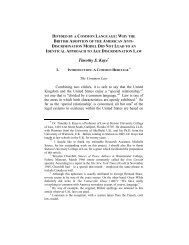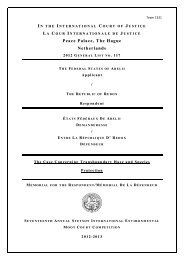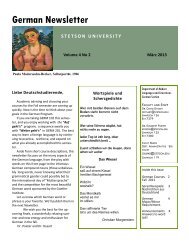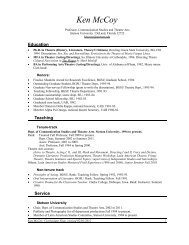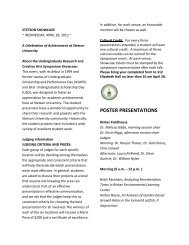Tiffany Huet Class of 2008 Justifying Violence: A ... - Stetson University
Tiffany Huet Class of 2008 Justifying Violence: A ... - Stetson University
Tiffany Huet Class of 2008 Justifying Violence: A ... - Stetson University
You also want an ePaper? Increase the reach of your titles
YUMPU automatically turns print PDFs into web optimized ePapers that Google loves.
enowned instances <strong>of</strong> religious resistance in history. Larry Rasmussen focuses on this question<br />
in his analysis <strong>of</strong> Bonhoeffer’s theology, ethics, and resistance: “If Christology is indeed at the<br />
center <strong>of</strong> Bonhoeffer’s thinking, where is the key here to his move from passive to active<br />
resistance?” 3<br />
Dietrich Bonhoeffer began as a pacifist, arguing that Christ was at the center <strong>of</strong> all reality<br />
and was “the man for others.” 4 His lectures on Christology in 1933 examine the meaning <strong>of</strong> faith<br />
and relationship with God in light <strong>of</strong> this understanding <strong>of</strong> Christ. He claims that faith is the<br />
human participation in Christ’s “being for others.” 5 What he meant by this was that Christ’s<br />
existence could only be seen in relationship with another person. Bonhoeffer says Christ “is his<br />
being pro me.” 6 In other words, Christ’s life on earth was intentional; his purpose was not, in any<br />
sense, selfish, given that others might find freedom and salvation. Christologically, since<br />
Bonhoeffer understood that Jesus was God emptied into a man, infinity emptied into a finite<br />
human being, everything—“[humanity], nature, and history” revolves around Christ. 7 He is the<br />
center for all reality, for Bonhoeffer. Moral action, judged from Bonhoeffer’s perspective, is in<br />
accordance with reality (Christ), and immoral action “deviates from Christ’s form in the world.” 8<br />
Christ’s being was oriented outwards, toward others and not toward himself. As Rasmussen<br />
concludes, “Bonhoeffer is declaring that because Christ is in, with, and under human sociality, a<br />
[human] only finds self-fulfillment, indeed self-formation, in being with and for others; and<br />
being with and for others is the way in which a [human] is formed in Christ.” 9 The “centrality <strong>of</strong><br />
3 Rasmussen, 36.<br />
4 Rasmussen, 18.<br />
5 Rasmussen, 21.<br />
6 Rasmussen, 18.<br />
7 Rasmussen, 15-16.<br />
8 Rasmussen, 23.<br />
9 Rasmussen, 20, italics mine.<br />
5



